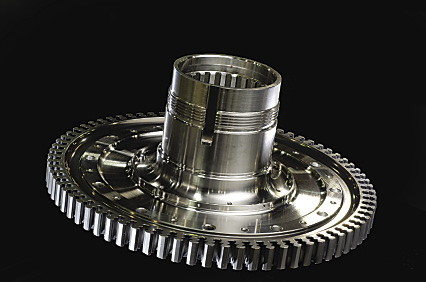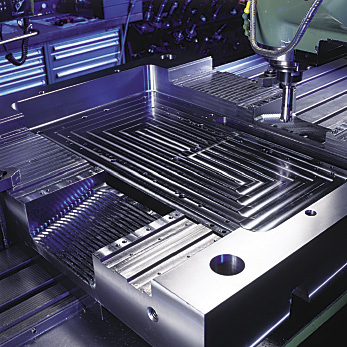Faustson Tool Corp. Vice President Heidi Hostetter is proud of her company’s status as an innovator. An adopter of 5-axis machining more than a decade ago, the Arvada, Colo., machine shop’s latest endeavor is bringing 3D metal printing to the forefront of Colorado’s manufacturing scene. Among Faustson’s awards, Ball Aerospace & Technologies Corp., Boulder, Colo., named it Platinum Supplier for 2014 and the shop was selected as a 2014 Colorado “Companies to Watch” finalist. Even with Faustson President Alicia Svaldi sitting on the boards of the Colorado Advanced Manufacturing Alliance (CAMA) and the Manufacturer’s Edge, and with Hostetter being a member of the Advanced Industries Accelerator Programs’ board for the Colorado Office of Economic Development and International Trade, the company isn’t content to rest on its laurels.
CTE: Why did Ball Aerospace name Faustson platinum supplier of the year?
Hostetter: Ball Aerospace did a national and international ranking, and we impressed them enough to top both. I personally have been working with them for 20 years, and Alicia (Svaldi) has for 30 years. Ball does quarterly reviews, and we had the highest review of any of their suppliers for a rolling year. They also had a classified government project called Aquila where we solved a major optical issue. They had a shim issue with an optic system, which created a lot of concern with Lockheed Martin and the end customer. We worked with Ball directly on that and not only solved the technical issue, but helped resolve a working relationship issue between Lockheed Martin and Ball.
CTE: What do Faustson’s connections to Manufacturer’s Edge and CAMA bring to the table?
Hostetter: Manufacturer’s Edge was formerly known as the Colorado Association for Manufacturing Technology, and they are the federal MEP (Manufacturing Extension Partnership) here, so Alicia being appointed to that board is awesome because she gets to give them insight on small, medium and large manufacturing. This is valuable to them because that’s who they are supposed to represent, and she can also give us insight into where they’re looking to spend their money and other things that factor into our business decisions. CAMA is the state-level representative, and she was asked to sit on their board as well, not only to provide the state and federal governments with the same data, but also to bring both organizations together and help them work together more fluidly.

Alicia Svaldi (left), president of Faustson Tool, and Heidi Hostetter, vice president, with the company’s Platinum Supplier for 2014 award from Ball Aerospace.

An aerospace part produced by Faustson Tool.

A machining setup at Faustson.
CTE: What makes Faustson stand out in the Colorado manufacturing landscape?
Hostetter: Our claim to fame is that we have a high-precision machine shop, including 3D metal printing and 5-axis cutting technology, but there are two specific things we really consider our forte. The first involves looking at a shop’s designs and saying, “Hey, if we do this and this, we can make the design more repeatable and cost-effective.” The second is we aim to be a technology innovator. For example, while most of the industry just recently started working to integrate and understand 5-axis technology, we started working with those machines 13 years ago. We are doing the same thing with 3D printing of aluminum and titanium. We try to pioneer new technologies as they become available.
CTE: How does that metallic process differ from a traditional 3D printing process?
Hostetter: Basically, like anything in the high-tech machining world, you start with a design file. Our software converts it to what’s called a “slice file,” and, from that, it generates the part by building it up in 20µm layers. The fact that it makes the part out of metal is what’s unique.
What we realized about 3 years ago was that a lot of the major OEMs were looking for someone to champion this technology, to learn it and utilize it, because, in the not-too-distant future, it will be crucial to manufacturing. So I decided to check it out and see if we might be able to be that shop. As I was researching, I found a couple of big voids, one of which is that there is no curriculum on the academic side, which makes it nearly impossible to learn or teach.
So, as you can imagine, it was pretty daunting. You’ve got all these people saying, “3D metal printing is the way of the future,” but we haven’t equipped our schools or our industry with the basic things they need to figure it out. That’s where we came into the picture in Colorado. We got a hold of the Office of Economic Development and International Trade, an arm of the governor’s office. A lot of this is still confidential, but we are working at a high state level on those issues right now, because the implications of 3D metal printing are much more than just implementing a new technology.
If you look up anything about the NNMI (National Network for Manufacturing Innovation), which the Obama administration is working on, you’ll see references to the pilot hub in Youngstown, Ohio, (which brings together manufacturers, universities, community colleges and nonprofit organizations for collaborative research). Colorado is mimicking that on a much smaller scale, and Faustson will be the representative for the 3D printing of metals within that “center of excellence.” We will take the next couple of years to learn this technology and hand off what we find to industry and academia. It represents a steep learning curve, because the standards and curriculum have yet to be developed. CTE
[Editor’s Note: A press release from Colorado Sen. Mark Udall reports the Department of Defense awarded more than $6.6 million in competitive grants to diversify Colorado’s economy and make the defense industry more resilient. The 2-year competitive grant will be used to promote public-private partnerships to sustain Colorado’s economy in the event of federal budget cuts affecting contractors. Faustson was named a stakeholder in that process.]







